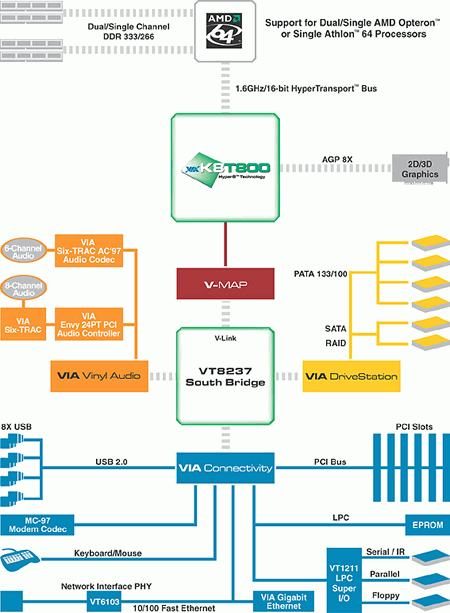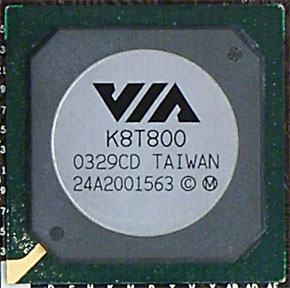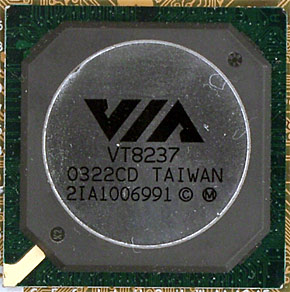VIA K8T800 chipset for AMD64
|
Waiting for Athlon 64 release VIA had time to prepare a chipset series for it and even replace it with another, newer one. Other makers were not this productive, so there's actually two Athlon 64 chipsets in the market today: VIA K8T800 and NVIDIA nForce3 Pro. We must say that there are no "pure" Athlon 64 chipsets as all K8 CPUs can be coupled with [any] chipset via HyperTransport, and the latter doesn't fundamentally distinguish CPU sockets/series available for either board. So why do we make reservations for "Athlon 64"? This isn't about technical specs, but positioning: AMD8000, the first actually released chipset, hasn't been used by any makers in an AGP-equipped motherboard. Needless to say, it wouldn't interest 90% of home users, while Athlon 64 is targeted at this specific group (not with the current price though).
Other solutions for AMD64 processors include ALi 1687 and SiS755/SiS755FX, but we haven't seen boards on them yet. ATI might catch up with some integrated solution next year, but still it's not about the nearest future. Anyway, two different chipsets in the market should raise Athlon 64/FX and Opteron core logic comparison question.
This question is not very obvious though. We know that with different innovations (original like nForce/2 DASP or obvious like two memory channels) or even without them chipsets from various companies might demonstrate totally different performance. However, what is the fundamental performance difference between chipsets, which have only AGP left of all the rich Northbridge core logic? Also consider that maximum bandwidth that this bus provides is not actually required by any 3D accelerator today. Of course, there are components connected via Southbridge, but they performs approximately equal and you won't feel the difference (remember that we speak of just the desktop chipset applications, ignoring the need for PCI-X, several Gigabit LAN connections and serious RAID arrays).
So what is left for makers to compete with? HyperTransport controller integrated into Northbridge comes into light very appropriately, and VIA bets on it most. The company promotes Hyper8 technology standing for 16bit/800MHz bidirectional HyperTransport CPU-chipset interconnect.

Indeed, nForce3-based boards support "just" 8bit/600MHz one way and 16bit/600MHz back. But such a formal difference doesn't play any important roles as in any AMD64 chipset only the AGP controller seriously consumes data (delivered over HyperTransport to memory via CPU-integrated controller), but its load isn't high at work. In the future this will be important for workstations and servers with PCI-X and PCI Express buses, but today it's some untimely. As BIOS of at least several K8T800-based boards enables adjusting HT bit depth and clock speed, we've conducted an express test using Return to Castle Wolfenstein and SPECviewperf and haven't found any performance differences in these modes. By the way, rivals are on the alert, for example, SiS already offers HyperTransport at 1GHz clock speed. :)
 
Below are the normal, not aggressively marketed features (Southbridge functionality is provided for VT8237, but nothing prevents from using any older VIA Southbridge):
- Supports AMD Athlon 64, Athlon 64 FX, Opteron (any series and
sockets)
- AGP 8x
- Bidirectional HyperTransport (CPU-chipset), 16bit/800MHz each
way
- V-Link 8x (533MB/s) for Southbridge connection
- 2 channels for 4 x Parallel ATA (ATA133) devices
- Supports 2 x Serial ATA (SATA150) devices
- 2 x Serial ATA devices via PHY controller (SATAlite)
- V-RAID for SATA RAID (JBOD, 0, 1, 0+1; the latter is for 4 SATA
simultaneous drives only)
- 8 x USB2.0 ports
- 6 x PCI devices
- Fast Ethernet MAC, up to 100Mbps
- AC'97 audio interface, up to 6 channels
- MC'97 modem interface
- LPC bus for legacy peripherals
Another fundamental moment is the chipset's chip count. NVIDIA has all core logic concentrated in a single crystal, while other companies (at least now) offer traditional dual-chip solutions. It's clear that the first is less flexible (you can't just change Southbridge that is improved more often without releasing a new chipset), but simpler. But for end users it's all the same, if this factor doesn't affect the street price.
Write a comment below. No registration needed!
|
|
 |
|
|
|



